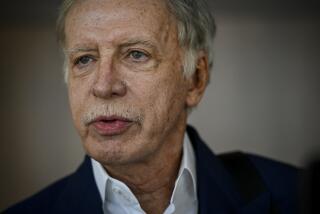Modern technology ages ‘Leatherheads’
- Share via
When using visual effects to give a movie like “Leatherheads” a period feel, one fumble and it’s all over. We’re not talking alien robots, explosions or otherworldly creatures here; these effects have to take audiences back to a real time and place.
So when George Clooney was prepping his loving ode to the early days of pro football, he huddled with boutique VFX house CIS Hollywood, which had contributed effects to the films of Clooney’s mentor, Steven Soderbergh, including “Erin Brockovich” and “Solaris” (it also didn’t hurt that their most recent project was the football-themed “We Are Marshall”). In “Leatherheads,” Clooney planned to show the evolution of football as a spectator sport, beginning with primitive pro games played in cow pastures, progressing to smaller arenas like Ennis Field and ending with a massive, double-decker Chicago stadium that would hold 30,000 people.
In each case, CIS worked alongside production designer Jim Bissell extending and dressing real locations to emulate the period stadiums.
During shooting, CIS measured the existing locales along with any set pieces Bissell added, then supplied digital set extensions plus hundreds, sometimes thousands of believable CG spectators in post-production. The most complex project was the Chicago stadium, which involved adding an extra tier of seats, an extremely detailed CG model of the upper-deck support beams in the foreground and a matte painting of the period Chicago skyline in the distance. “We used stills of 1920s Chicago to compose our matte painting,” says visual-effects supervisor Tom Smith, “then added all these subtle tricks -- clouds, moving cars, smoke -- to give a little life and get away from the static look of a painting.”
The crowds filling the stands were created using the famed Massive software that brought clashing armies of orcs and elves to life in “The Lord of the Rings” trilogy, only instead of wielding weapons, these digital creations had to kibitz, jump and cheer. To augment the Massive and live action crowd, CIS did a motion capture session involving just one employee, whose personality now permeates the stands. “Whenever someone in the crowd’s talking or gesturing,” Smith says, the model’s “personality comes through.”
So with such subtle additions, how does CIS know if its work is a success?
If nobody notices a thing, that’s how. “If it doesn’t draw attention to itself,” Smith says, “we consider it a compliment.”
More to Read
The biggest entertainment stories
Get our big stories about Hollywood, film, television, music, arts, culture and more right in your inbox as soon as they publish.
You may occasionally receive promotional content from the Los Angeles Times.










